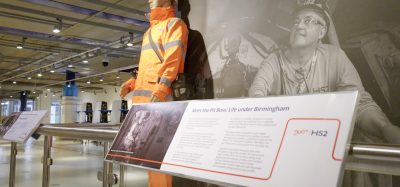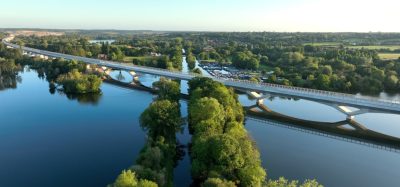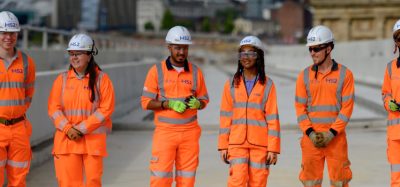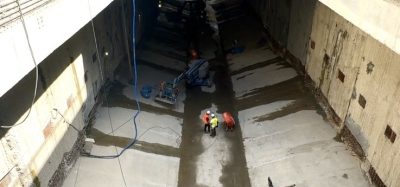Infrabel feverishly continues working on Liefkenshoek rail link
Posted: 28 January 2010 | | No comments yet
Infrabel, the Belgian railway infrastructure manager, is busy working on building a direct rail link between the Left and the Right Bank in the Port of Antwerp: the Liefkenshoek rail link. In mid-January 2010, the project company LOCORAIL NV started boring the first of two tunnel shafts. In a conversation with Global Railway Review, Luc Vansteenkiste, Infrabel’s Director General of Access to the Network, explains this spectacular work, the safety aspects and the importance of this prestigious project for Infrabel and the Port of Antwerp.
Infrabel, the Belgian railway infrastructure manager, is busy working on building a direct rail link between the Left and the Right Bank in the Port of Antwerp: the Liefkenshoek rail link. In mid-January 2010, the project company LOCORAIL NV started boring the first of two tunnel shafts. In a conversation with Global Railway Review, Luc Vansteenkiste, Infrabel’s Director General of Access to the Network, explains this spectacular work, the safety aspects and the importance of this prestigious project for Infrabel and the Port of Antwerp.
Infrabel, the Belgian railway infrastructure manager, is busy working on building a direct rail link between the Left and the Right Bank in the Port of Antwerp: the Liefkenshoek rail link. In mid-January 2010, the project company LOCORAIL NV started boring the first of two tunnel shafts. In a conversation with Global Railway Review, Luc Vansteenkiste, Infrabel’s Director General of Access to the Network, explains this spectacular work, the safety aspects and the importance of this prestigious project for Infrabel and the Port of Antwerp.
The Liefkenshoek rail link
In line with its strategy, Infrabel is gradually expanding its capacity at those places in the network where this is necessary, including in the Port of Antwerp. Infrabel already, in an initial phase, expanded and renovated the rail infrastructure on the Antwerp Left Bank, including the area around the Deurganck dock. This €100 million investment results in 153km of additional tracks and track bundles.
But in order to best manage the cargo traffic, a new direct rail link between the Left Bank (Waaslandhaven) and Right Bank (shunting station Antwerpen-Noord) is needed: the Liefkenshoek rail link. Train traffic from the Deurganck dock will travel faster and more efficiently because it can continue straight to Antwerpen-Noord where the trains are put together.
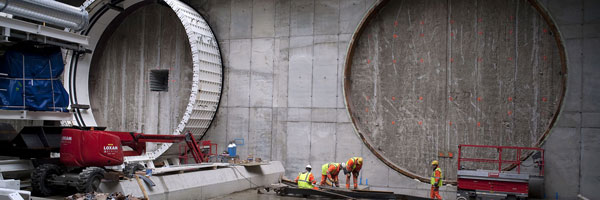

Infrabel will start boring the first of two tunnel shafts from the departure shaft in January 2010
Public Private Partnership
The Liefkenshoek rail link is built using a public private partnership (PPP). The financial closing and the award of the building contract were completed on 5 November 2008. The private partner, LOCORAIL NV, consists of the building companies CFE NV, VINCI Concessions SA and BAM PPP Investments België. LOCORAIL NV assigned the construction parts of the project to the THV LOCOBOUW consortium, which consists of CEI-De Meyer, MBG, Wayss & Freytag, VINCI Construction Grands Projets and Smet Tunnelling.
The specially established project company LOCORAIL NV is responsible for the design, building, financing and maintenance (DBFM formula). Infrabel will be able to use the infrastructure for 38 years on the condition that it pays an annual compensation of approximately €50 million for the tracks being available. After that period Infrabel, as its owner, can continue to use this infrastructure without any further obligations.
Excavations on the first tunnel shaft started
In mid-January 2010 – under the authority of Infrabel – LOCORAIL NV started boring the first of two tunnel shafts (each approximately 6km). Two separate tunnel shafts will be bored, each with a diameter of 8.10 metres (outside diameter), from west to east beginning from the starting shaft on the Left Bank to the receiving shaft on the Right Bank. In March 2010, work will start on boring the other tunnel shaft using a second similar tunnel boring machine (TBM), so that both borings can be performed simultaneously and the installations can be completed in a timely fashion.
In November 2009, the cutting shield, the cutting wheel and the parts of the TBM reached the Deurganck dock from Germany (Schwanau) after travelling by boat over the Rhine and the Scheldt. After a number of special transports over the road, all TBM parts reached their assembly point (near the Ploegweg). Subsequently, the cutting shield and the five support wagons for the boring machine were lowered into the starting shaft and the tunnel behind it. The assembly itself took more than two months after which the boring could begin.
Rail tunnel runs 40m deep under the Scheldt river
Boring the two shafts takes place beneath the water level of the Scheldt (approximately 40m), from the Channel dock B1-B2 (approximately 30m), thus causing minimal disruption to marine traffic. Both tunnels will be bored separately using a 102m-long boring machine, proceeding with assistance from a high-pressurised water shield (‘hydromix shield’). The entire two-tunnel operation will take approximately 1.5 years; boring will progress at an average speed of 20m a day.
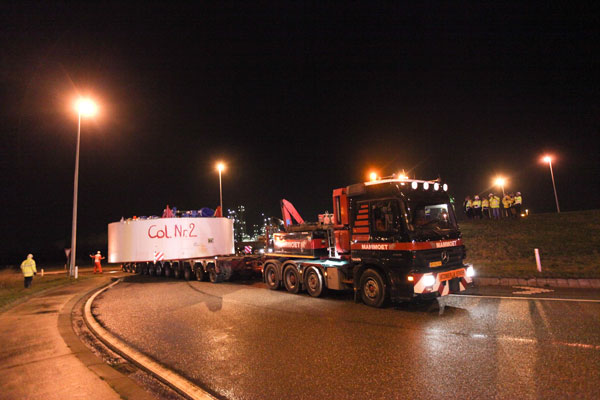

In mid-November 2009, the cutting shield was transported by a special night-time transport from the Deurganck dock to its assembly point on Antwerp’s Left Bank
The machine acts like a mole underground, comparable to the construction of the north-south link underneath the Antwerp Central railway station and the Diabolo (the other Infrabel PPP project) under Brussels Airport. The work for the Liefkenshoek rail link is supervised by TUC RAIL, the research agency for railway technology that acts on Infrabel’s behalf.
Link with Bundel-Zuid and Antwerpen-Noord
The 16.2km route of the Liefkenshoek rail link starts at Left Bank in the rail cluster South. From there, the railway bed will be built covering a distance of 6.5km to the existing Beveren rail tunnel (1.2km), which will be adapted and renovated. The work for the partly open linking tunnel and the access ramp between the Beveren railway tunnel and the starting shaft at the Ploegweg are well under way.
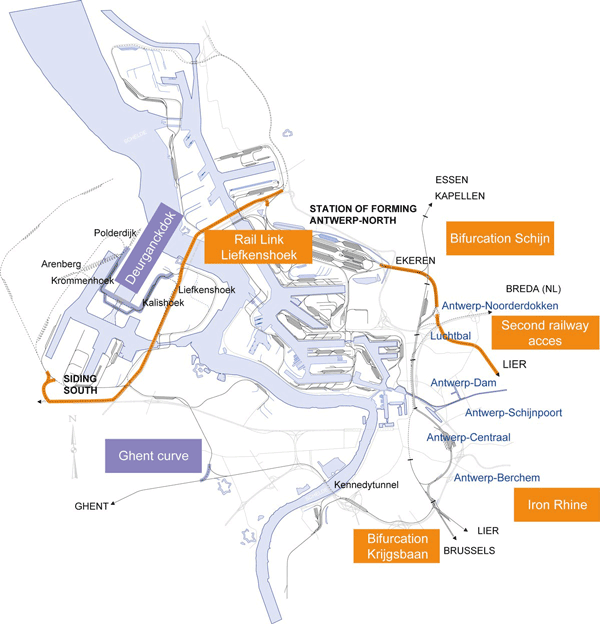

Outline of the rail infrastructure projects in the Port of Antwerp with the Liefkenshoek rail link route
The bored tunnels run underneath the Scheldt and the channel dock B1-B2 in the direction of the reception shaft near the Kruisweg on the Right Bank. The preparation for that reception shaft is progressing rapidly, just like the building of an access ramp to that shaft and the adaptation of an existing rail tunnel (75m) under the R2. A little further on, a link will be built with the shunting yard Antwerpen-Noord, the end of the 16.2km-long Liefkenshoek rail link.
Safety: an absolute priority
For the Liefkenshoek rail link project safety is an absolute priority, too. For example, access roads and access shafts to the tunnels are being built for access by emergency services. Work on a number of the total of 14 evacuation shafts is currently under way. Protection (e.g. against vandalism, trespassing) is also integrated into the safety case.
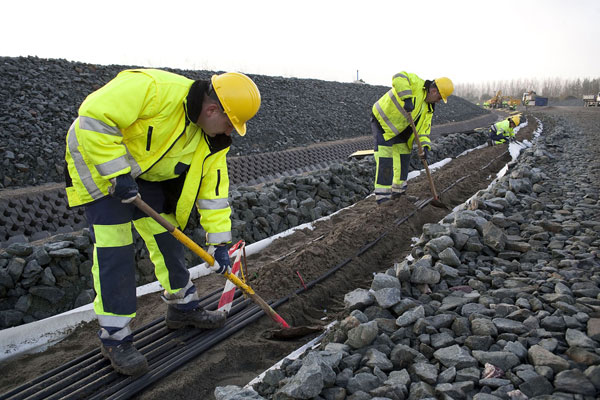

Rail workers actively work on the 6.5km-long railway bed between Bundel-Zuid and the existing Beveren rail tunnel
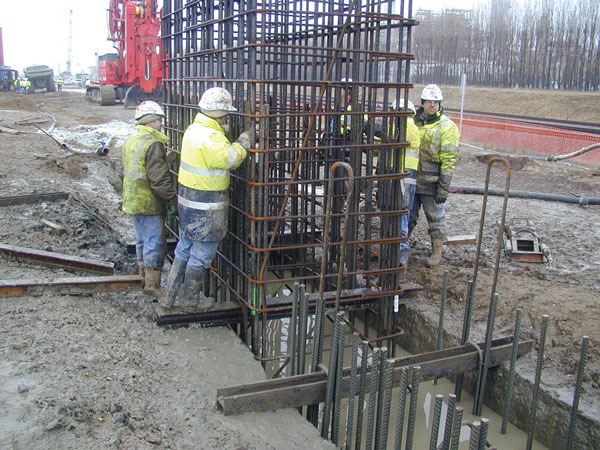

Also at the Liefkenshoek rail link, safety has absolute priority, including through the building of 14 evacuation shafts along the entire route. This image shows the foundation works for one of the evacuation shafts
Another important focus of attention is fire safety. The rail tunnel will be equipped with the latest fire detection systems (e.g. cameras and communication devices), fire fighting (e.g. Smoke and Heat Discharge System), and after-care (e.g. buffer basins for the water). At the fire department’s request, an automatic foam extinguishing system will also be installed.
Sustainable integration and planning of the work
In addition to these activities in the area of building and safety, Infrabel will integrate the Liefkenshoek rail link in a sustainable manner into the environment by building a nature compensation area, a number of sound buffers and sound barriers.


The rail works of the Liefkenshoek rail link (16.2km) include two single-track bored tunnels (6km) under the Scheldt
The building consortium THV LOCOBOUW started work on the construction of the Liefkenshoek rail link on 12 November 2008. The building work will be completed in mid-2013. During the period 2012-2014, Infrabel will perform the work on the tracks, overhead wiring and signals. Starting in the spring of 2014 the rail infrastructure of the Liefkenshoek rail link will be tested. After the required approvals, Infrabel will make this new rail link available to the railway operators by mid-2014.
Investing in better accessibility of the Port of Antwerp
As regards the construction works, this project will be financed through a public-private partnership by the project company LOCORAIL NV (CAPEX of approximately €690 million (current)). The Flemish Region will provide co-financing in the amount of €107 million. However, building of the rail infrastructure will be financed by Infrabel in an amount of approximately €75 million (current) and is not a part of the DBFM order. The total investment for the Liefkenshoek rail link is approximately €765 million (current).
The Liefkenshoek rail link fits into Infrabel’s strategy of gradually expanding the capacity of the railway infrastructure and progressive support of the growth of the Port of Antwerp. Infrabel wants to increase the share of container freight by rail in the Port of Antwerp from the current 8% to approximately 15% by 2020 to meet increased freight transport demand.
The Liefkenshoek rail link will also have a major impact on the economic development of the Port of Antwerp, including creating many additional jobs. This railway project is also part of a strategy to provide an optimal intermodality between the railway and the ports of Antwerp, Ghent and Zeebruges.
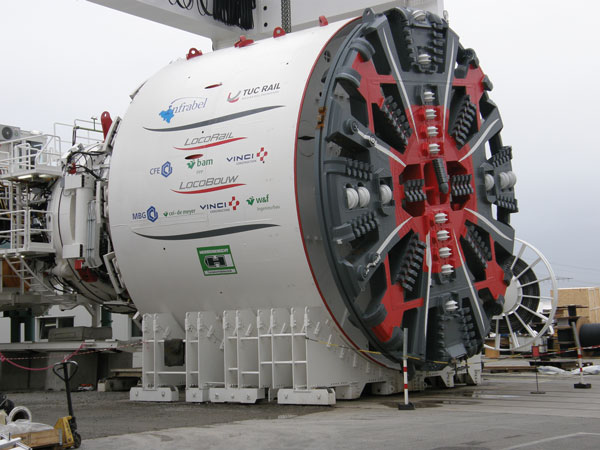

A 102m-long tunnel boring machine (shown here during tests at the Herrenknecht company in Germany) drills one of the 6km-long rail shafts at 40m under the Scheldt
Key figures on the boring shield and the bore tunnel
- Length of the bore tunnels: 2 x 5,972m
- Outside diameter tunnel: 8.10m
- Inside diameter tunnel: 7.30m
- Length of each segment: 1.80m
- Machine type: Mixshield Slurry TBM
- Diameter of the boring shield: 8.39m
- Length of the boring shield: 11.70m
- Length of the support structure(s): 90m (5m x 18m)
- Total weight of the boring shield: 1,250 tonnes
- Electric power of the cutting wheel: 1,100 kW


Luc Vansteenkiste
About the author
Luc Vansteenkiste has held many positions at various companies throughout his career, including among others, Managing Director of Eurostar Group Ltd and Eurostar UK Ltd (1998-2000) and CEO of BENE-IT NV (a branch of SNCB in 2002-2004).
Mr. Vansteenkiste is President of RailNetEurope, Manager of EESV Corridor C and Director of TUC RAIL.
Stay Connected with Global Railway Review — Subscribe for Free!
Get exclusive access to the latest rail industry insights from Global Railway Review — all tailored to your interests.
✅ Expert-Led Webinars – Gain insights from global industry leaders
✅ Weekly News & Reports – Rail project updates, thought leadership, and exclusive interviews
✅ Partner Innovations – Discover cutting-edge rail technologies
✅ Print/Digital Magazine – Enjoy two in-depth issues per year, packed with expert content
Choose the updates that matter most to you. Sign up now to stay informed, inspired, and connected — all for free!
Thank you for being part of our community. Let’s keep shaping the future of rail together!



